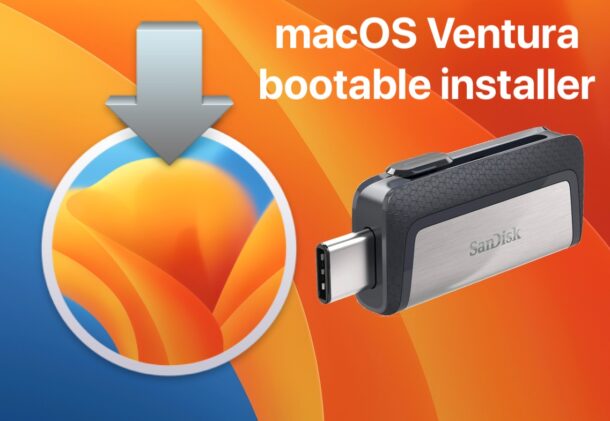How to Create a Bootable macOS Ventura USB Install Drive

Creating a bootable macOS Ventura installer can be desirable for many advanced Mac users, whether to perform clean installations, install macOS Ventura 13 onto multiple machines without having to re-download the installer, to serve as a recovery boot disk, or any other number of reasons.
Making a macOS Boot install drive is not particularly difficult, but it does require using the command line.
Before getting started, make sure you have the following prerequisites covered:
- Download the macOS Ventura installer application to the Mac /Applications folder if you haven’t done so already
- A macOS Ventura compatible Mac
- A 16GB or larger USB flash drive which will be erased to create the installer drive
How to Make a MacOS Ventura Installer Drive
Creating the boot installer takes a few steps:
- Connect the USB flash drive that will become the boot installer to the Mac
- Rename the USB drive something obvious, like “VenturaUSB” in the Finder
- Open the Terminal application on the Mac by hitting Command+Spacebar to open Spotlight, then typing
“Terminal” and hitting return - Enter the following command string into the terminal, the following syntax assumes you named the USB installer drive as ‘VenturaUSB’:
sudo /Applications/Install\ macOS\ Ventura.app/Contents/Resources/createinstallmedia --volume /Volumes/VenturaUSB --nointeraction - Hit return and enter the administrator password
- The macOS Ventura boot installer drive will be created and the Terminal will update on progress and completion
When you’re done, you can eject the USB installer and use it on any compatible Mac with Ventura by booting it like any other bootable drive.
The boot installer can be used to upgrade other Macs to macOS Ventura 13, or to perform clean installations.
How to Boot from the MacOS Ventura Installer Drive
Booting from the installer depends on the system architecture of the Mac you’re using it on.
Booting from Installer Drive on Mac with Apple Silicon (M1, M1 Pro, M2, etc)
- Connect the USB boot drive to the Mac
- Turn off the Mac
- Press and hold the Power button on the Mac with the USB drive connected, continue holding the Power button until you see a Startup Options screen
- Choose the installer for macOS Ventura to boot from
Booting from Installer Drive on Intel Mac (X86)
- Connect the USB boot installer drive to the Mac
- Turn off or restart the Mac
- Immediately press and hold the Option key at system start, continue holding holding you see the boot volumes menu available to select from, and choose the macOS Ventura installer from here
After you’re booted from the macOS Ventura installer, you can proceed to the installer for macOS Ventura to upgrade the Mac or to perform a clean install, use Disk Utility to perform tasks like creating containers or partitions, use Time Machine for restoring, and more.


Can one do this with a burnable dvd disc for Ventura? Or put Ventura on I should say? And where is the direct link to Ventura actually? It’s one thing to have an install assistant. But people are gonna need the actual os/dmg file.
Brilliant – worked first time!±
This was very helpful. I had to experiment a bit with where their are spaces since it’s not that obvious in the command and I wasn’t smart enough to try cut and past. There is a space before MacOs, before Ventura and after –volume. Cut and paste is likely to be your best friend for this (but I haven’t tried it yet…)
I tried this a got the same errors. Having just read your article from January 26, I checked and the USB drive came formatted as exFAT. Does the drive need to be reformatted as “MacOS Extended (Journaled)” for the command line commands to work?
Yes it does.
I am attempting to create bootable USB drive per your article ref above. When I use terminal command as given in your article ‘sudo /Applications/Install\ macOS\ Ventura.app/Contents/Resources/createinstallmedia –volume /Volumes/VenturaUSB –nointeraction’, I get ‘sudo: /Applications/Install macOS Ventura.app/Contents/Resources/createinstallmedia: command not found’
I successfully have used sudo commands in the past in terminal.
Usually the ‘command not found’ error is either due to syntax or the installer is not where it should be. Syntax looks fine, so presumably you either don’t have the installer application in your Applications folder, or the installer is not a complete installer.
Go to your /Applications folder and look for the installer app for “Install macOS Ventura” and make sure it is there. Then, select the installer, and use Get Info to see how large the file size is. The full installer should be several GB in size.
You can download a full installer for 13.1 from here if needed:
https://osxdaily.com/download-macos-ventura-13-full-installer/
You need to run install InstallAssistant.pkg first, the check for Install macOS Ventura in your Application folder
I got: “command not found”
Did you enter all three lines at once?
There is no “:” after sudo
If you downloaded InstallAssistant.pkg, you have to open it and “install” it to your computer. This basically just places “Install macOS name.app” into your application folder (it won’t overwrite anything on your computer). You can use the default settings when running the InstallAssistant.pkg installer.
Then run the command.